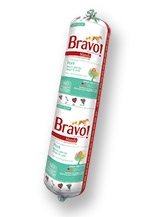Bravo Blends Pork Review
PawDiet has been helping pet owners since 2015. To fund our efforts, articles may include affiliate links; if you buy something through a link, we may earn a commission.
Review of Bravo Blends Pork
According to our most recent data, this product is intended for intermittent or supplemental feeding only.
Review of Ingredients
In our review of Bravo Blends Pork, we'll examine all 8 ingredients and highlight the nutritional contribution of each ingredient.
While the first few ingredients typically dominate the recipe's composition, ingredients in small quantities can still have a meaningful impact on the overall nutritional profile of the recipe.
Pork is a high-quality source of protein, essential for muscle development and maintenance, and provides vital nutrients for your dog's overall health.
Pork bone provides a natural source of calcium and phosphorus, which are vital for maintaining strong bones and teeth in your dog.
Pork Heart is an excellent source of protein, B vitamins, iron and essential amino acids, making it a beneficial component of your dog's diet.
Pork liver is a nutrient-rich organ meat that provides a plethora of essential vitamins and minerals, including iron, vitamin A, and B vitamins, which help support your dog's overall health.
Pork kidney is a nutrient-dense protein source for dogs, providing essential vitamins and minerals, including iron, zinc, and vitamins A and B. It supports overall health, including immune function, cognitive health, and energy production.
Bok choy provides vitamins A, C, and K, along with calcium and iron, promoting healthy vision, immune system, and bone health.
Acorn squash is a nutrient-dense vegetable that provides an excellent source of vitamins A, C, and potassium, as well as dietary fiber. These nutrients can support your dog's immune system and digestive health.
Romaine lettuce is a low-calorie, nutrient-rich ingredient used in some dog foods. It provides essential vitamins and minerals, such as vitamin K, vitamin A, and folate, which contribute to your dog's overall health. Romaine lettuce is also a good source of dietary fiber, supporting a healthy digestive system.
Review of Guaranteed Analysis
Crude Protein (min) of 16.50%: The primary contributors to the crude protein content in Bravo Blends Pork are the pork meat, pork heart, pork liver, and pork kidney. These are all rich sources of protein, which is essential for the growth and maintenance of a pet's muscles and overall health. The pork meat, being a substantial part of the product, likely provides the bulk of this protein, while the organs (heart, liver, kidney) are known to be particularly dense in high-quality proteins and other nutrients.
Crude Fat (min) of 12.50%: The crude fat content is mainly derived from the pork meat and pork bone, as these contain the natural fats of the animal. Pork is known for having a higher fat content compared to other meats, which contributes to the energy density of the food. The organs, such as the pork liver and kidney, may also have some fat, but to a lesser extent. Fats are crucial for providing energy, supporting cell structure, and aiding in the absorption of fat-soluble vitamins.
Crude Fiber (max) of 1.00%: The crude fiber content is relatively low, which is typical for meat-based pet foods. The bok choy, acorn squash, and romaine lettuce are the ingredients contributing to the fiber content. These vegetables provide the necessary fiber to aid in digestion and promote intestinal health. However, since the product is predominantly meat-based, the fiber content remains minimal.
Calories of 1800.00 per kg: The caloric content is a measure of the energy provided by the food. In this case, the calories mainly come from the protein and fat in the pork meat and organs. Since fats provide more than twice the calories per gram compared to proteins and carbohydrates, the significant amount of fat in this pet food is a key contributor to its caloric density. The vegetables included may contribute some calories, but their impact is minimal compared to the caloric contribution from the meat and fat.

